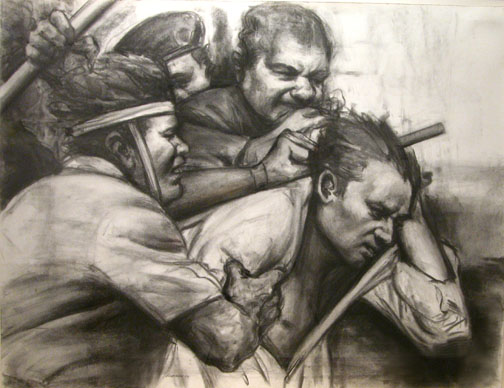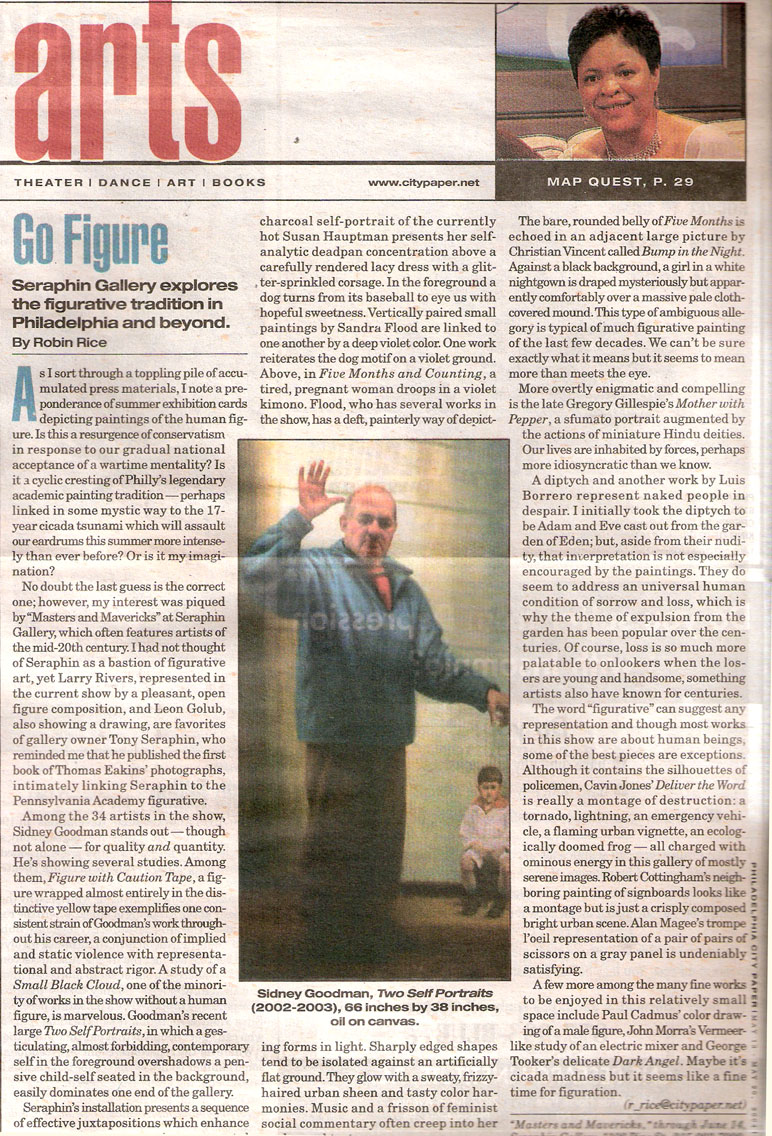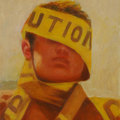Posted on Sun, Jul. 5, 2009
Art: Dramatic drawings need not defer
Philadelphian Sidney Goodman invests as much in them as in his paintings.
![]()

In the hierarchy of art media, painting traditionally trumps drawing, which was for centuries a means of capturing impressions and testing compositional ideas. This is no longer true, nor, as far as I can tell, has it ever been so for Sidney Goodman.
One of Philadelphia's most successful, respected, and influential artists, the 73-year-old Goodman has always drawn prolifically, and has always invested as much energy, intellect, and emotion in his major drawings as he does in his paintings.
It's significant, for instance, that more than 40 percent of the works in his 1996 retrospective exhibition at the Philadelphia Museum of Art were drawings.
Now the Pennsylvania Academy of the Fine Arts, where Goodman has taught since 1978, has put up a show of 64 drawings and watercolors made over the last 30 years.
Selected by Julien Robson, curator of contemporary art, the show delivers the equivalent power and complexity of the 1996 retrospective. If you haven't seen any other show of Goodman's art, "Man in the Mirror" puts you dead center in his world.
(The Goodman show is half of a concurrent pair of PAFA retrospectives featuring longtime academy instructors who are among the city's artistic elite. The other features painter Elizabeth Osborne. A commentary on her show, "The Color of Light," will appear July 19.)
Goodman is a figurative artist, but not necessarily a realist. He is as much concerned with what visual representation can't reveal as he is with what registers on the retina. Both his paintings - some of these are on view at Seraphin Gallery through July 28 - and his drawings typically address intangibles such as states of mind, emotions, dreams, and fantasies.
Ambiguity and duality are his bywords. Many drawings suggest more than one interpretation, which can be maddening for viewers who expect an image composed of recognizable forms to make complete sense. Even Goodman's portraits of his immediate family, perhaps the most conventional pictures in the show, suggest layers of meaning beyond documentation.
Add to that the fact that Goodman is relentless in exposing human foibles, fears, failings, and barbarities, even his own. His drawings can be rough going for the squeamish because gratuitous violence and its consequences are a common theme.
Some drawings are bluntly and even grotesquely erotic (Urban Lovers, Bodies in Motion, Love Knot) and others, particularly Birth Control and The Struggle, are violently confrontational.
Goodman isn't all hard knocks and rough edges; his drawings of his wife, Pam, and his three children, Luke, Maia, and Amanda, and of his late mother expose his tender side. He's not sentimental, but he's consistently capable of touching intimacy.
He draws with vigorous, sweeping strokes, usually in charcoal, which produces heavy black outlines and dense passages of shadow. Darkness dominates, for instance, in Urban Lovers and Child Near Source, which depicts a young Luke standing next to a large tree. In this, the area of penumbral darkness is relieved, and dramatized, by a bright blaze of sunlight on the tree trunk.
In some drawings, the stark heaviness is counterpointed by blushes of lush color, usually a shade of red or red-orange, rendered in pastels. The color sometimes represents blood, as in Bloody Head With Fist, but more often it provides feminizing counterpoint, especially when used to highlight skin.
The most notable example is Night Vision, in which a dormant female nude is juxtaposed against the ominous, writhing coils of what might be a giant serpent.
Such striking contrasts are common in Goodman's drawings. He has expressed a fascination with light effects, but it's also possible that the near-absence of light stands metaphorically for those truths about human behavior and the psyche that evade direct observation. This tension between what can be seen and what can only be imagined constitutes the foundation of Goodman's art.
He composes with three basic ingredients - observation, readily recognized in images of his children; memory; and imagination. The last sometimes takes the form of implausible or humorous fantasy - Goodman self-portrayed in a boxer's stance while balancing himself on a large ball, or Goodman leering at three tiny Wonder Woman dolls.
The ball image could be a comment on the precariousness of life itself, an eternal balancing act, or on the way artists, especially this artist, struggle to reconcile the demands of art-making and truth-telling with being a father and husband, with being honest in art and in life.
Goodman is a severe judge of human nature; he's particularly censorious of the mindless violence so prevalent in American cities, the gratuitous brutality that keeps tabloid newspapers and the 6 o'clock news in business. He doesn't spare himself this scrutiny, he doesn't stand apart from the passing parade of hapless humanity beset by doubt, immobilized by fear, or derailed by passion.
These conditions are usually conveyed by symbols such as the serpentlike coils reminiscent of the famous classical sculpture the Laocoön Group; by large spheres, which surround and support a young Luke in Birthday, and which suggest instability or uncertainty; and by scenes of violence or chaos.
In its gravity and its unsparing emotional intensity, Goodman's art revivifies late 19th-century symbolism while obliquely recalling the demonic power of Francisco Goya in his Disasters of War suite and also, to a lesser extent, in Los Caprichos. Goodman's drawings are essence, not entertainment or diversion. They're more often disturbing than soothing. They might give you bad dreams, but they will also expand your consciousness.
Paintings at Seraphin. The current Goodman show at Seraphin Gallery of nine oils, two drawings, and a lithograph helps to put the academy exhibition in context. The paintings depict images of destruction, chaos, anxiety, confinement, rage and struggle, all encoded symbolically.
Like the drawings, the paintings tend to be muscular, both in the way they're brushed and in the contorted features of some of the protagonists, especially two men climbing opposite sides of a pinnacle. Even son Luke is shown encoiled, like Laocoön and his sons, in yellow plastic caution tape.
But in one corner of the gallery, gentility and repose assert themselves in an unusual sleeping nude. The model, apparently Goodman's wife, is bifurcated. Her torso and legs occupy the top portion of the canvas, while her head and shoulders anchor the bottom, like a magician's partner sawn in half. In this case, the parts are more intriguing than the whole.
______________________________________________________________________________________________________________
Art: Man in the Mirror
![]() "Sidney Goodman: Man in the Mirror" continues in the Hamilton building of the Pennsylvania Academy of the Fine Arts, Broad and Cherry Streets, through Sept. 20. Hours are 10 a.m. to 5 p.m.Tuesdays through Saturdays and 11 to 5 Sundays. Admission to special exhibitions (includes permanent collection) is $15 general, $12 for seniors and students with ID, and $8 for visitors 5 through 18. Information: 215-972-7600 or www.pafa.org.
"Sidney Goodman: Man in the Mirror" continues in the Hamilton building of the Pennsylvania Academy of the Fine Arts, Broad and Cherry Streets, through Sept. 20. Hours are 10 a.m. to 5 p.m.Tuesdays through Saturdays and 11 to 5 Sundays. Admission to special exhibitions (includes permanent collection) is $15 general, $12 for seniors and students with ID, and $8 for visitors 5 through 18. Information: 215-972-7600 or www.pafa.org.
![]() "Sidney Goodman: Strange Clarity" continues at Seraphin Gallery, 1108 Pine St., through July 28. Hours are 11 a.m. to 6 p.m. Tuesdays through Sundays. Information: 215-923-7000 or www.seraphingallery. com.
"Sidney Goodman: Strange Clarity" continues at Seraphin Gallery, 1108 Pine St., through July 28. Hours are 11 a.m. to 6 p.m. Tuesdays through Sundays. Information: 215-923-7000 or www.seraphingallery. com.
_______________________________________________________________________________________________________________
"Broad Street Review"
An Old Master at 71, still growing
ANNE R. FABBRI
Welcome home, Sidney Goodman. It’s been a long, long time, and we missed you. This exhibition of 20 paintings and drawings by one of Philadelphia’s most prestigious artists is the first in this city since Goodman’s major exhibition at the Philadelphia Museum of Art in 1996. And now the art world has caught up with him.
Goodman’s work looks as if he must have been the mentor for all the young artists featured in New York’s Chelsea galleries. Images from photographs, with all their distortions of depth and focus, in high intensity colors, define today’s art. Goodman began it years ago, and he’s still in the lead. He might be an Old Master of 71, but his work continues on the edge.
Goodman follows the traditional dictum: Never complain; never explain. You, the viewer, interpret each painting however you please. Or just immerse yourself in the sensuous painterly quality of each one and forget about story-telling. Man in Water (1999), depicts only a man’s head above the water. It looks like a self-portrait, reminding us that most art is autobiographical. There is no struggle, so the subject must be an expert swimmer, enjoying the refreshing dip in gently moving water. Goodman, with charcoal and pastels on paper, has managed to communicate all the pleasurable sensations of a late afternoon dip mid-summer.
A riff on renaissance Madonnas
The Struggle (1995-1996), another charcoal and pastel on paper 58” x 42,” creates a maelstrom of intertwined male and female figures. Women’s swelling breasts protrude between men’s legs on the lower right center. Female legs can be followed separately from the hairy, masculine limbs weaving throughout the knot of figures. It definitely portrays men and women in turmoil, beautifully rendered throughout. What does it mean? Who cares? The art is in the work itself; read into it whatever you want. Goodman is not a narrative painter. He is a visual artist.
Goodman’s figures are as realistic as those of John Currin and Lisa Yuskavage— last year’s stars of the New York art scene— but they’re not meant to recall individuals encountered on the street. Instead they are images with a different purpose. The large, 46” x 70” Floating Woman with Men (2005, oil on canvas), is a beautifully painted riff on all those Renaissance Madonna paintings depicting a full-bodied Madonna floating through the air while the male Apostles stand helplessly, looking up. Think of Titian’s Assumption of the Virgin in the Frari Church, Venice. Goodman’s female figure just exists. She’s not questioning her unusual situation; again, it is all up to you, the viewer.
Legs Above, Head Below (2006, 83” x 48” oil on canvas), captures Goodman’s sheer mastery of figure painting along with an enigmatic composition that hints at much more than you might want to consider. Is she the victim of violence? It doesn’t look that way. But what are those red splotches on the lower right? And is that a shadow of a man’s head?
In the Eakins tradition
Goodman’s use of photographic references goes back to Thomas Eakins. It’s in the Eakins tradition and it isn’t, depending what you do with the references. Goodman no longer needs to employ a model. Just as we know how to write our names in the dark, he knows how to draw and paint male and female bodies. Brushes, crayons and pencils are only the beginning, but they always capture a sense of the human spirit.
Goodman populates his work with family members, friends and passers-by, all of whom remain purely symbolic and this accounts for their timeless imagery. He paints Everyman, writ large. We furnish the biography. Therefore it can change from year to year.
Goodman’s work seems to be reaching a new level of expression. He has eliminated many of the extraneous touches that formerly bothered me and has achieved clarity of expression and technique that enhances everything. He has taught at the Pennsylvania Academy of the Fine arts since 1979, and his paintings hang in the permanent collections of major museums here in Philadelphia and at the Museum of Modern Art in New York, the Metropolitan Museum of Art, Whitney Museum of American Art, Art Institute of Chicago and many others. He enjoys a well-deserved national recognition; Europe and Asia should follow.
___________________________________________________________________________________________________________

Seraphin Gallery l Contemporary Philadelphia Art Gallery and Art Consultant
1108 Pine St. l 215-923-7000 l seraphin@seraphingallery.com


